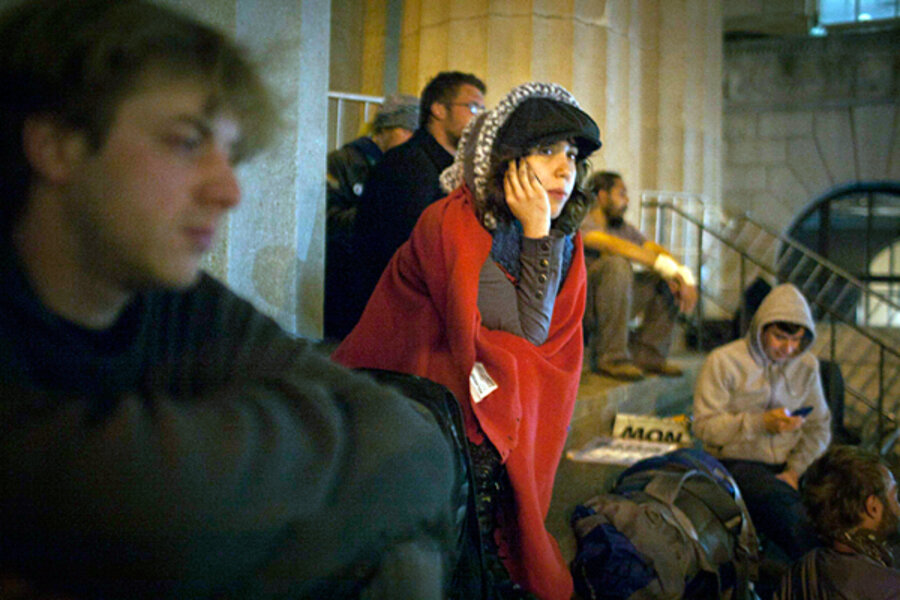Occupy May Day: Can the protest movement spring back to life?
Loading...
| Los Angeles
As Occupy Wall Street mobilized for its May Day of global action, many who watched the tent-powered movement flower last fall wondered if this day would mark the group’s spring awakening or offer final proof that the movement died when the snow fell and the campers went home.
Though Occupy’s initial successes have had a lasting impact on the national conversation and political agenda, analysts say, the movement is still plagued by a lack of focus and faces a struggle to recapture public support.
While solidarity actions have continued sporadically from coast to coast for the past six months, the kinds of clashes and high-profile media coverage that defined the movement’s first four months have largely stopped.
Activists say their work has just begun.
“We are most definitely still here,” says David Intrator, a New York filmmaker and musician who says anyone who thinks the Occupy movement has died doesn’t understand the endeavor. “We are here for the long haul,” he says. "We are the Energizer bunny of social movements,” because the goal is consciousness-raising, not merely creating platforms or agendas.
That larger goal aside, however, he points to what he calls a season of progress.
Since its eviction from New York’s Zuccotti Park in mid-November, Occupy Wall Street has grown into a movement with many centers and many actions, he says.
At least 10 candidates for office in the fall have formally aligned themselves with the Occupy movement, and former high-level government officials are coming up with ways to create a new banking system, all under the OWS brand, says Mr. Intrator.
The semantics of the movement have clearly influenced the general election, he says, “even forcing Mitt Romney to frame his platform on the idea of ‘fairness.’ ”
Over the winter, the Occupy movement augmented its strength by organizing on specific topical areas, says Heather Gautney, political science professor at Fordham University in NewYork. These include “corporate personhood, equitable taxation, and housing foreclosure (Occupy our Homes),” she says via e-mail.
The movement has also sponsored civil disobedience training in various cities, she notes. In New York, for example, she says, “they organized weekly training sessions on nonviolent street tactics; in Washington, D.C., a splinter group, called ‘the 99 percent Spring,’ staged a mass civil disobedience training session, attracting tens of thousands of people, including big labor and groups like moveon.org.”
She does allow that the movement has suffered losses, noting that “the movement appears to have lost some traction in opinion polls and the central camp occupations have been almost entirely cleared.”
Tents aside, however, the activists are losing the most important battle, says Karen Tramontano, a Washington-based expert on government and social movements. “They have lost the battle for the hearts and minds of the public,” she says. “This is very unfortunate because the issues of fairness and income inequality that initially sparked the movement’s appeal in the public are still very much present.”
The fallback is largely a result of the group’s failure to coalesce around clear steps forward, she says. She notes that many Occupy groups have indeed begun to work with existing progressive movements in local issues around the nation, “but in the absence of large efforts that many people can coalesce around, it will be very difficult for the movement to sustain any sort of national power.”
Perhaps reflecting an awareness of a shift in the public appetite for the Occupyers, there have been pullbacks in planning for Tuesday’s actions, most notably the scrapping of a plan to blockade San Francisco’s Golden Gate Bridge. Among the main actions planned for the day are marches, strikes, and walkouts.
The Occupy movement is clearly in the midst of an identity crisis, says Usha C.V. Haley, professor of international business at Massey University in Auckland, New Zealand.
She notes that the Tuesday strikes may well bring people out in support, but “they will also increase irritation as the actions disrupt the daily flow of life and they will tend to brand the Occupyers as troublemakers and ne’er-do-wells.”
Tuesday’s strikes may well put the Occupyers back on Page One for a moment, says Michael Robinson, executive vice president of Levick Strategic Communications in Washington, “but the real question they have yet to answer is what do they really want as a group that the public can get behind?”







